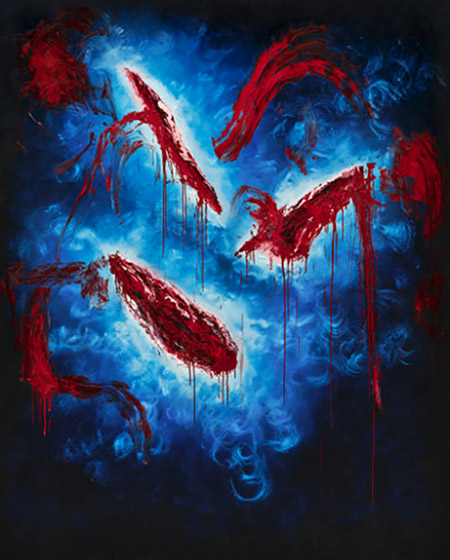
Continuing through April 15, 2023
Best known internationally for his conceptual installation sculptures that explore the boundaries of form and the tricks of perception, Anish Kapoor also has sustained a robust drawing and painting practice throughout his career. In this exhibition, the British-Indian artist, who has lived and worked in London since the early 1970’s, fills the gallery with three groups of large-scale paintings. Like Richard Wagner’s “Ring” cycle, the show transports us into archetypal mythic spaces brimming with chthonic, creation-story texture and energy in paintings that illuminate themselves from the inside with Turner-like explosions of light. The paintings also pay homage to American Abstract Expressionism with inwardly directed vectors that heroically see passageways into the unknown.
As with Kapoor’s sculptures, some of these paintings feature industrial-slick surfaces that reflect, refract, spin, and hurl shimmering imagery back out into the world with a nostalgic nod to the Light and Space movement of 1960’s Los Angeles. In both his sculpture and painting Kapoor works inside the liminal space between the material and immaterial worlds, and in so doing makes the familiar more difficult to see. While the artist works with fabricators and technicians on his sculptures, he creates the paintings alone, applying pigment with a combination of thick and thin hairbrushes, sticks, and his own hands.
Five paintings titled “Blood in the Sky” occupy the gallery’s west wall and present an HD-sharp sequence of canvases that posit metaphorical snapshots of the Big Bang and the inception of life on earth. From a timeless firmament of opaque black paint, iridescent royal blue and white pods seem to grow protective skins around one or more impastoed, inchoate blood-red blobs. Trails of translucent chalk-like vertebrae drift down and around from the center of each canvas, connecting one painting in the sequence to another in a syntax of organic growth and change.
On the gallery’s adjacent wall, the cool blues and whites of the preceding works are replaced with masses of fiery reds and aggressive blacks. This sequence of work pulses both inwardly and outwardly, suggesting the lava whirlpools of the earth’s fiery core and the bursts of countless galaxies receding into cosmic space.
Yet it is raw emotion that occupies center stage here. In “Shudder,” for example, the image of a flaming, blood-soaked vagina rimmed and guarded by lips of stony teeth, contrasts female sexuality and pleasure against paroxysms of fear at the thought of physical union and emotional intimacy. By contrast, tenderness, lightness of touch, and the nurturing potential of femininity filters through and radiates from “Turning the World Upside Down,” where in a calligraphic and doily-like stringy web, the artist blends grandeur with the pastoral restraint of classic Dutch and Chinese landscape art. This show celebrates Kapoor’s broad technical ability and his expressive range and intensity. It’s a side of him that complements and broadens the aesthetic drama of his more familiar public work.
